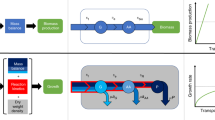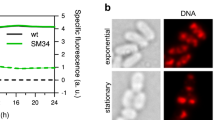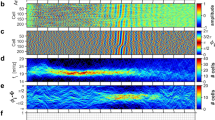Abstract
IN the course of an investigation1 on the reduction of formaldehyde by a strain of Pseudomonas æruginosa, it was demonstrated that treatment of the bacteria with single amino-acids that were able to support adequately their growth in culture media, prior to the addition of formaldehyde, considerably enhanced the subsequent rate of uptake of the latter compound by the organism. This rise in reducing activity was assumed to be related to processes preparatory to cell multiplication. Pollock and Wainwright2 found that the nitratase activity of washed suspensions of the coliform organism ‘1433’ was markedly stimulated in the presence of tryptic meat broth or a mixture of eighteen amino-acids. They suggested that, in accordance with Spiegelman and Dunn's theory3, the external supply of nitrogen would serve as a source for the synthesis of more enzyme protein.
This is a preview of subscription content, access via your institution
Access options
Subscribe to this journal
Receive 51 print issues and online access
$199.00 per year
only $3.90 per issue
Buy this article
- Purchase on Springer Link
- Instant access to full article PDF
Prices may be subject to local taxes which are calculated during checkout
Similar content being viewed by others
References
Kopper, P. H., J. Gen. Physiol. (in the press).
Pollock, M. R., and Wainwright, S. D., Brit. J. Exp. Path., 29, 223 (1948).
Spiegelman, S., and Dunn, R., J. Gen. Physiol., 31, 153 (1947).
Author information
Authors and Affiliations
Rights and permissions
About this article
Cite this article
KOPPER, P. Relationship of Growth-Phase to the Reducing Activity of Bacterial Cells. Nature 167, 951–952 (1951). https://doi.org/10.1038/167951a0
Issue Date:
DOI: https://doi.org/10.1038/167951a0
Comments
By submitting a comment you agree to abide by our Terms and Community Guidelines. If you find something abusive or that does not comply with our terms or guidelines please flag it as inappropriate.



